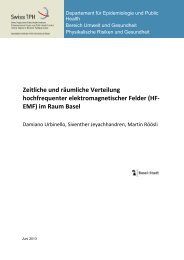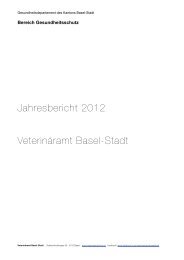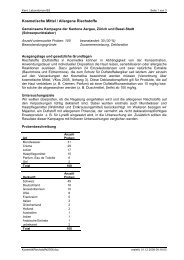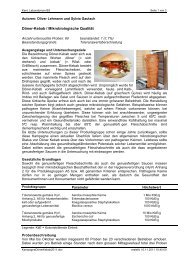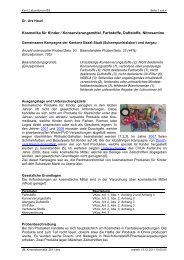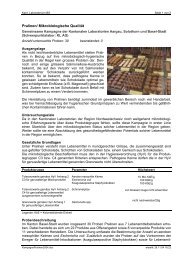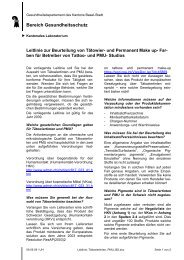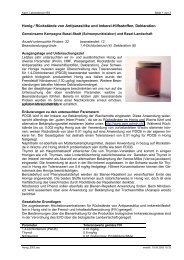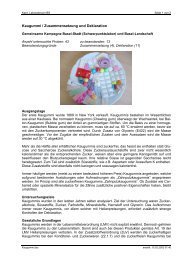Bericht als PDF herunterladen
Bericht als PDF herunterladen
Bericht als PDF herunterladen
You also want an ePaper? Increase the reach of your titles
YUMPU automatically turns print PDFs into web optimized ePapers that Google loves.
Kant. Laboratorium BS Page 3 of 4<br />
Colourants<br />
No non-permitted colourants or pigments were detected. Phthalocyanin pigments (C.I. 74160<br />
and 74260) were the most common colourants used to produce blue and green tones. Azo and<br />
quinoline colourants were most commonly used for yellow, orange and red colours – this colour<br />
group <strong>als</strong>o contained the majority of the 31 non-identified colourants and pigments.<br />
One sample contained Pigment Red 2, which is not on the positive list for finger paints. It is<br />
however covered by EN 71/7, 4.2.2, according to which all colourants which are not classified<br />
as being carcinogenic, mutagenic, teratogenic, very toxic, toxic, harmful to health, corrosive,<br />
irritant or sensitizing may, nevertheless, be used as colouring agents in finger paints.<br />
C.I. Number<br />
C.I. Level<br />
Number of<br />
samples<br />
C.I. 74160 Pigment Blue 15 13<br />
C.I. 74260 Pigment Green 7 10<br />
C.I. 47005 Acid Yellow 3 6<br />
C.I. 16255 Acid Red 18 4<br />
C.I. 42051 Acid Blue 3 4<br />
C.I. 11680 Pigment Yellow 1 3<br />
C.I. 21100 Pigment Yellow 13 3<br />
C.I. 11710 Pigment Yellow 3 1<br />
C.I. 12310 Pigment Red 2 1<br />
C.I. 77007 Pigment Blue 29 1<br />
C.I. 77268 Food Black 3 1<br />
Iron oxide 1<br />
Titanium dioxide 1<br />
not identified 31<br />
Total 80<br />
Aromatic amines as impurities or following reductive cleavage<br />
• The finger paints investigated did not contain detectable levels of carcinogenic primary<br />
aromatic amines according to 4.5. The tertiary aromatic amines Michler’s ketone, methane<br />
base and auramine O were likewise not detected.<br />
• In one sample, approx. 7 mg/kg o-toluidine following reductive cleavage with sodium<br />
hydrosulfite (according to EN 71/7). This was just under the limit value of 10 mg/kg, but<br />
indicates that o-toluidine is present as a pigment component. The red pigment itself could<br />
not be identified.<br />
Declaration<br />
Not for the first time, warning notices were not present in all three official languages (5 of 14),<br />
as required due to Switzerland being a trilingual country. It is however astonishing that so many<br />
products bearing the CE label do not conform to the requirements of European Standard 71/7<br />
regarding declaration and warning notices. The declaration of preservatives and bittering<br />
agents, required by the standard was absent in no less than 8 of 14 cases. In one case, only the<br />
trade name for the preservative, which will mean little to the consumer, was used. The warning<br />
notice “Caution! Children under 3 years must be supervised by an adult” was completely absent<br />
from two packs.<br />
Measures taken<br />
The Canton in which the importer is based is responsible for measures taken. Sale of samples<br />
containing MI/MCI in excess of the limit value was forbidden.<br />
Conclusions<br />
• The requirements for finger paints are clearly defined in a European standard. All samples<br />
carried the CE sign, thereby indicating their conformity with EN 71/7. Despite this, 12 of 14<br />
finger-paint sets failed to fulfil important aspects of this standard, casting the manufacturers<br />
and their accrediting agencies in a poor light. Indeed, analytical investigations had to be<br />
carried out in our laboratory to demonstrate the limit value exceedance and absence of<br />
bittering agents, whereas simple inspection of the formulations and packaging would have<br />
Report0602.doc compiled: 25.01.06 07:31:00



